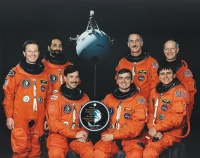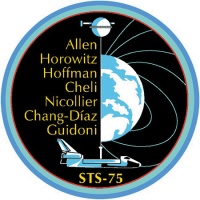STS-75
From The Space Library
 | |
| Organization | NASA-Office of Space Flight (United States) |
|---|---|
| Mission type | Human Crew,Space Physics |
| Launch date | February 22, 1996 |
| Launch vehicle | Space Shuttle |
| Launch site | Cape Canaveral, United States |
| COSPAR ID | 1996-012A |
| Inclination | 28.45 degrees |
| Experiments | Here |
| Alternate Names | 23801 |
| Additional Information | Here |
| Data Collection | Here |
| Payload Mass Up | 10592 kg |
| Payload Mass Down | 10574.09 kg |
| Orbiter | Columbia |
| Lift Off Mass | 2,057,496.82 kg |
| Orbiter Weight at Liftoff | 118,859.55 kg |
| Orbiter Weight at Landing | 103,895.91 kg |
| Landed | Concrete runway 33 at Kennedy Space Center, Fla. |
| Orbits of Earth | 252 |
| Orbital Altitude | 160 nautical miles (184 statute miles) |
Contents |
Crew
- Commander: Andrew M. Allen
- Pilot: Scott J. "Doc" Horowitz
- Payload Commander: Franklin R. Chang-Diaz
- Mission Specialist 1: Jeffrey A. Hoffman
- Mission Specialist 2: Maurizio Cheli, European Space Agency
- Mission Specialist 3: Claude Nicollier, European Space Agency
- Payload Specialist 1: Umberto Guidoni, Italian Space Agency
Mission
The STS-75 mission was the 75th shuttle mission and the 19th flight of the Columbia orbiter. The primary tasks of this shuttle flight were to conduct experiments as part of the third flight of the United States Microgravity Payload (USMP-3) and to deploy the joint Italian-US Tethered Satellite System (TSS-1R). The TSS-1R mission was a reflight of TSS-1 which was flown onboard Space Shuttle Atlantis on STS-46 in July/August of 1992. During that flight, the tether was deployed a distance of 860 feet. STS-75 mission scientist hope to deploy the tether to a distance of over 12 miles (20.7km). The Tether Satellite System circled the Earth at an altitude of 296 kilometers which placed the tether system within the rarefied electrically charged layer of the atmosphere known as the ionosphere. The conducting tether generated high voltage and electrical currents as it moved through the ionosphere across the magnetic field lines of the earth. Scientists were able to learn more about the electrodynamics of a conducting tether system to deepen our understanding of physical processes in the near-Earth space environment. These studies will help provide explanations for events such as the formation and behavior of comet tails and bursts of radio "noise" detected from other planets. The specific TSS1-R mission objectives were: characterize the current-voltage response of the TSS-orbiter system, characterize the satellites high-voltage sheath structure and current collection process, demonstrate electric power generation, verify tether control laws and basic tether dynamics, demonstrate the effect of neutral gas on the plasma sheath and current collection, characterize the TSS radio frequency and plasma wave emissions and characterize the TSS dynamic-electrodynamic coupling. TSS-1R Science Investigations include: TSS Deployer Core Equipment and Satellite Core Equipment (DCORE/SCORE), Research on Orbital Plasma Electrodynamics (ROPE), Research on Electrodynamic Tether Effects (RETE), Magnetic Field Experiment for TSS Missions (TEMAG), Shuttle Electrodynamic Tether System (SETS), Shuttle Potential and Return Electron Experiment (SPREE), Tether Optical Phenomena Experiment (TOP), Investigation of Electromagnetic Emissions by the Electrodynamic Tether (EMET), Observations at the Earth's Surface of Electromagnetic Emissions by TSS (OESSE), Investigation and Measurement of Dynamic Noise in the TSS (IMDN), Theoretical and Experimental Investigation of TSS Dynamics (TEID) and the Theory and Modeling in Support of Tethered Satellite Applications (TMST). The USMP-3 payload consisted of four major experiments mounted on two Mission Peculiar Experiment Support Structures (MPESS) and three Shuttle Mid-deck experiments. The experiments are: Advanced Automated Directional Solidification Furnace (AADSF), Material pour l'Etude des Phenomenes Interessant la Solidification sur Terre et en Orbite (MEPHISTO), Space Acceleration Measurement System (SAMS), Orbital Acceleration Research Experiment (OARE), Critical Fluid Light Scattering Experiment (ZENO) and Isothermal Dendritic Growth Experiment (IDGE). During this flight, the tether on TSS-1R broke after the satellite had been deployed to a distance of 19.7 km. The shuttle ended its mission after 251 orbits and a total mission duration of 15 days, 17 hours, 41 minutes, and 25 seconds.
Payload
Tethered Satellite System (TSS) Reflight (1R); Orbital Acceleration Research Experiment (OARE) (part of United States Microgravity Payload 3); USMP-3; Commercial Protein Crystal Growth (CPCG) 09, Block IV; Middeck Glovebox Experiment (MGBX) (part of USMP-3)
Books about the Space Shuttle Program
Buy This Book Click here |
Buy This Book here |
Buy This Book Click here |
Buy This Book Click here |





